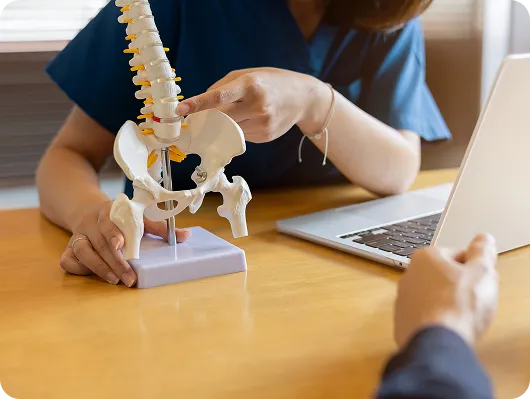Sacroiliac Joint Pain Treatment
Minimally invasive care to relieve pain and restore joint stability

Understanding SI Joint Pain and Its Root Causes
Sacroiliac (SI) joint pain is characterized by discomfort or pain in the sacroiliac joints – located in the lower back where the sacrum (the triangular bone at the base of the spine) connects to the ilium bones of the pelvis. These joints play a critical role in transferring forces between the upper and lower body during activities like walking or running.
When swelling, instability, or injury affects the sacroiliac joints, it can lead to SI pain. Early recognition of symptoms can support an accurate diagnosis and more effective treatment.
Understanding SI Joint Pain and Its Root Causes
Sacroiliac (SI) joint pain is characterized by discomfort or pain in the sacroiliac joints – located in the lower back where the sacrum (the triangular bone at the base of the spine) connects to the ilium bones of the pelvis. These joints play a critical role in transferring forces between the upper and lower body during activities like walking or running.
When swelling, instability, or injury affects the sacroiliac joints, it can lead to SI pain. Early recognition of symptoms can support an accurate diagnosis and more effective treatment.

Causes of Sacroiliac Joint Pain
Several factors can contribute to SI joint pain, including:
Inflammation: Inflammatory conditions in the spine could affect the sacroiliac joints leading to SI pain.
Injury or trauma: Physical trauma in the sacroiliac joint leads to the development of SI joint pain.
Pregnancy and childbirth: As the body changes during pregnancy, the hormonal changes loosen the sacroiliac joints, causing SI joint pain.
Infection: When the SI joint becomes infected by conditions such as septic arthritis, it could cause pain.
Symptoms of Sacroiliac Joint Pain
Typical symptoms associated with SI joint dysfunction include:
✔ Lower back pain
✔ Pain in the hips or buttocks
✔ Discomfort in the groin region
✔ Pain that worsens with sitting, standing, or specific movements
✔ Difficulty maintaining certain positions for extended periods
Diagnosing Sacroiliac Joint Pain
To determine the root cause of SI joint pain, a healthcare provider may:
Review your medical history
Conduct a physical examination focused on the lower back and pelvis
Order imaging studies such as X-rays, MRIs, or CT scans
Perform electromyography to evaluate nerve and muscle activity
Treatment Options for Sacroiliac Joint Pain
Once diagnosed, several treatment strategies may be recommended depending on the severity of the condition:
Conservative Therapies
Conservative therapies are non-invasive procedures, often using the patient’s body to reestablish its structure. This can include massage therapy, acupuncture, or chiropractic care. These treatments could help release tension trapped within the sacroiliac joints, decreasing pain and restoring mobility.
Lifestyle Changes
Some tips that could help your sacroiliac joints release pressure include performing low-impact exercises like swimming or cycling, having a healthy diet to manage your weight, and maintaining good posture by using ergonomic chairs
Non-Opioid Medications
Medications that provide pain relief without the risks of opioids:
✔ NSAIDs (nonsteroidal anti-inflammatory drugs) to reduce inflammation
✔ Muscle relaxants to alleviate spasms and nerve pressure
Injections
Image-guided injections provide targeted relief:
✔ Corticosteroids: Reduce inflammation and pain in the affected area
✔ Nerve block injections: Interrupt pain signal transmission to the brain
Pain Management Procedures
Pain management techniques can significantly improve quality of life since no pain will be felt during recovery. Doctors recommend using pain management options along with treatments that focus on restoring your spinal mobility:
✔ Transcutaneous electrical nerve stimulation (TENS) involves the usage of low-voltage electrical currents to disrupt the transmission of pain signals.
✔ Radiofrequency ablation uses radio waves heat to help reduce nerve irritation.
Neuromodulation
Spinal cord stimulation is a type of neuromodulation treatment that uses electrical impulses to modify the nerve activity in the spine. As the nerve signals become blocked by this stimulation, the pain won’t be felt even though the symptom source remains.
On the other hand, peripheral nerve stimulation uses electrical stimulation to target peripheral nerves around the spinal cord.
Minimally Invasive Interventions
Effective for restoring joint stability and reducing pain:
✔ SI joint fusion: Involves stabilizing the joint using screws or rods to encourage bone healing
✔ Radiofrequency ablation: Uses heat from radio waves to disrupt pain signals
SiLO™ Procedure for SI Joint Pain
The SiLO™ implant offers a minimally invasive solution to stabilize the sacroiliac joint. The procedure uses a single implant system made of human cortical bone (allograft) to fuse and stabilize the SI joint, resulting in pain relief.

Care That’s Close to Home
We offer care from two convenient clinic locations, making it easy to access expert medical support close to home.
Each facility is designed to provide a welcoming, safe, and efficient environment equipped with advanced technology and supported by a compassionate team dedicated to your well being.
Tualatin Clinic
Newberg Clinic
Care That’s Close to Home
We offer care from two convenient clinic locations, making it easy to access expert medical support close to home.
Each facility is designed to provide a welcoming, safe, and efficient environment equipped with advanced technology and supported by a compassionate team dedicated to your well being.
Tualatin Clinic
Newberg Clinic

Why Choose Spinal Diagnostics?
Patients choose Spinal Diagnostics for our comprehensive approach, accurate diagnostics, and compassionate care. We stay at the forefront of interventional procedures and are committed to improving your quality of life—without opioids or invasive surgeries.
Proven Medical Expertise
We bring years of clinical experience in pain management and interventional procedures.
Constant Innovation
We use the latest techniques and technology to ensure safe, effective treatment.
Compassionate Care
We listen, understand, and treat every patient with empathy and respect.
Personalized Plans
Each treatment is tailored to your condition, goals, and lifestyle.
Explore the treatments that bring real relief.
Learn how our non-invasive solutions and personalized plans can help you feel better, faster.
Explore the treatments that bring real relief.
Learn how our non-invasive solutions and personalized plans can help you feel better, faster.

